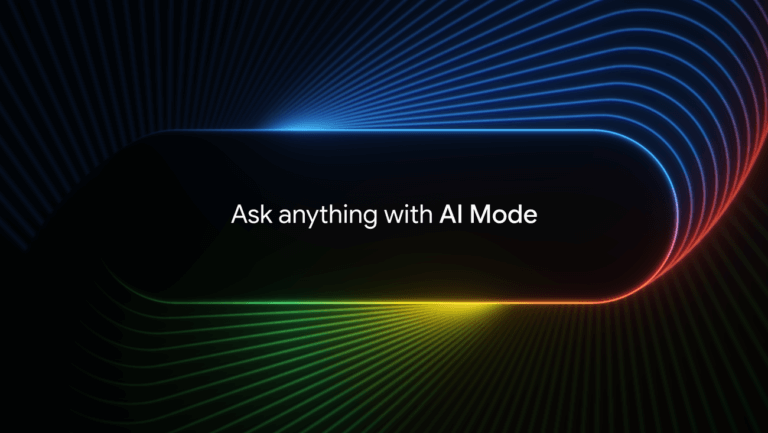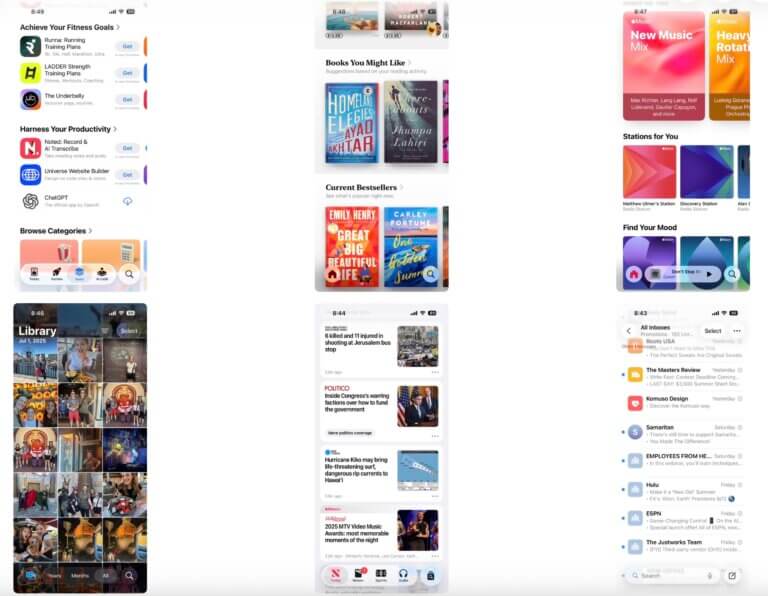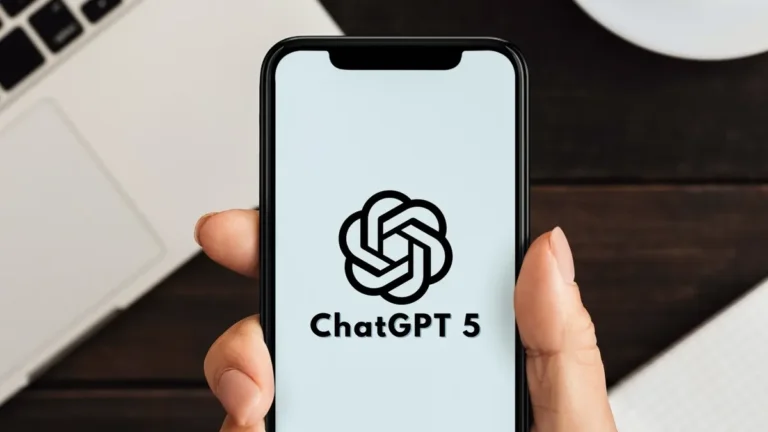Google AI Mode is here!
Huh?
What’s funny about working in digital marketing is that we become so immersed in this world, we assume everyone is aware of the same things we are.
This came up on a recent business call, when I mentioned AI Mode, and others on the call stared at me with a single expression:
Huh?
So, since we’re all here and eager to learn together, let’s talk about Google AI Mode. What it is, what it wants to be, and what it means for users and marketers.
What is AI Mode?
In short, it’s Google’s response to ChatGPT, or perhaps more accurately, SearchGPT. There’s a tab at the top of the Google search bar that says AI Mode, and if you click it, you get a chat interface, like you’ve no doubt used to ask ChatGPT to write a love song for penne a la vodka (you haven’t all done that before?).

When you conduct a search in AI Mode, you don’t get the classic Google search engine results page we’ve all grown to tolerate and depend on over the past decade. You don’t even get an AI Overview box. You get a chat experience where you can continue talking to Google to get more information, advice, or ideas for love songs devoted to pastas (“Layers of Love: An Oad to Lasagna” is pretty good).
But don’t take my word for it. Let’s ask AI Mode what AI Mode is:
If you’ve dabbled with AI-generated summaries or tested new AI search results, you’ve already gotten a taste. AI Mode is Google’s ambitious effort to reshape how information is delivered — layering AI-generated answers directly atop the familiar search engine results page (SERP).
Pretty succinct, if a tad over-indulgent. Google’s ambitious effort to reshape how information is delivered. Some might argue it’s Google unambitious efforts to copy Chat/SearchGPT’s effort to reshape how information is delivered, but why quibble with a machine?
Especially since AI Mode wasn’t done. It also wanted me to share with you its list of “key features”:
- AI-generated “snapshot” answers to search queries
- Inline citations to sources
- Related links and follow-up prompts
- Available on mobile and desktop (with gradual rollout)
Perhaps most importantly, it capped off its explanation of itself with this: It’s not just a novelty — it’s the future of how people will experience Google Search.
I should pause here to note that, for the entirely of this article, anything in italics is pasted directly from Google AI Mode. Alright, let’s keep it moving.
What are the Advantages of AI Mode?
Advantages for Users
Of course, I had to ask AI Mode what it thought its advantages were. Sell me on your services, AI Mode. Why should I care?
I kid you not, in response to a prompt about the advantages of AI Mode, it actually stated: Why should users care? Was it reading my mind?
Also, how did it answer?
Because AI Mode makes search faster and more conversational:
- Instant answers: No need to sift through 10+ articles — AI Mode summarizes the top takeaways.
- Natural language: Complex questions yield more natural, nuanced answers.
- Smarter exploration: Follow-up questions and topic suggestions encourage deeper discovery.
- For everyday users, AI Mode feels like a personal researcher — ready to serve answers on a silver platter.
This is all pretty accurate, but also not any different from the benefits of other generative AI chat tools. Really, the answer here is that it works just like ChatGPT but is built into your Google search bar. In other words: It’s potentially more convenient (unless you’re on a Mac with the ChatGPT app, then nothing is more convenient than hitting Option and the spacebar and having a ChatGPT search bar pop right up ((once Siri gets its act together, it might become slightly more convenient than that (((did I just put parenthesis inside of parenthesis inside of parenthesis? The Inception of keyboard characters? See, this is why human involvement is still needed — what AI would think to do this!))) )) ).
Advantages for Marketers
I didn’t just want to know what AI Mode thought its advantages were for everyday users, I wanted to know why it thought it was a good thing for marketers. I appreciated that it sensed my underlying suspicion and tried to soothe me by pretending we’re part of the same gang. It told me: Here’s the good news for us marketers: AI Mode isn’t just a black hole that steals clicks. Done right, it can be a traffic driver and brand builder.
And then came more bullet points:
- Credible exposure: If your content is cited in the AI summary, you appear in a position of authority.
- New engagement paths: Follow-up links and deeper question prompts give users more entry points to your content.
- Content quality rewarded: AI Mode heavily favors well-structured, informative, trustworthy content — giving strategic SEO and content marketing even more value.
Once more, all of this is accurate, with a possible caveat. Google is saying it wants quality content, and in theory, if this is true, companies that take the time to write quality, relevant content will be rewarded with brand references and links. But a very reasonable fear is that many companies will (and currently are) use(ing) AI to mass produce generic, unedited, unfact-checked content (what some have dubbed “slop”), and that the AI systems ingest this slop that they themselves have spit out and now we have a snake-eating-its-tail cycle of AI generating content and then referencing that content and nothing on the internet is good or trustworthy anymore.
Let’s all hope for the quality content reward angle, whatya say?
Are There Drawbacks? Of Course There Are Drawbacks
Disadvantages for Users
I couldn’t let AI Mode off too easily. I had to know if it was aware of its own drawbacks. Consider it an open and honest job interview or performance review — what are your biggest weaknesses?
And AI Mode didn’t shy away from real talk. It answered: AI Mode isn’t all rainbows. There are real trade-offs.
Sounds ominous. Let’s continue:
- Accuracy varies: While often impressive, AI summaries can still contain hallucinations or misinterpret nuanced topics.
- Source transparency: Not every statement is clearly cited — making it harder to verify information.
- Over-simplification: Complex or controversial topics can get flattened into oversimplified narratives.
At this point, AI Mode even included its own little “too long, didn’t read” recap:
TL;DR: AI Mode makes search faster, but not always better.
What a line. To me, it magnificently sums up the entire generative AI landscape right now. AI makes whatever you’re doing faster, but not always better.
Thank you for your honesty, AI Mode. Now let’s really dig into the real meat of it all — how will an absence of Google listings impact websites that rely on traffic from Google listings?
Disadvantages for Marketers
This is the big one. Or as AI Mode put it: This is where it gets tricky.
- Fewer clicks: AI Mode can answer a user’s question without them ever visiting your site.
- Brand dilution: Your content may power the AI summary without driving actual brand recognition or engagement.
- Citation roulette: Not all good content is surfaced or credited — Google’s algorithms aren’t perfect.
First off, credit to the phrase “citation roulette.” But beyond that, credit to Google for being uncharacteristically transparent (and talking about itself in the third person). Matt thinks this is a bold admission, and it’s of course completely true: If users opt to use AI Mode, they may completely bypass a need to visit your website.
This has obviously already been the case with ChatGPT, Claude, Perplexity.ai, and others, but though those platforms are all gaining ground, Google still controls the vast majority of market share when it comes to searching for something online. Google switching to the chat model will bring the largest search upheaval yet.
It would be wise for me to point out here that if you aren’t already, you very much need to be participating in AI Search & Answer Engine Optimization. This will help your brand be cited more often, and your website linked to more often. This is absolutely crucial to continued digital success. Frankly, it’s crucial to overall business success. Start optimizing for AI answer engines right now.
What’s Next for AI Mode?
I figured I’d take a shot and ask AI Mode what’s next for AI Mode. Does the answer provide any deep company insights? Of course not, AI Mode might talk about itself in the third person, but it’s no dummy able to be tricked into revealing trade secrets.
More telling than its inclusions was its exclusion: No mention of ads. Don’t worry, ads are definitely coming to AI Mode.
Instead, here is the answer I received:
Google’s AI Mode is in its infancy. Expect it to grow up quickly. Here’s what’s likely on the horizon:
- More transactional prompts: Google will likely integrate shopping, booking, and conversion prompts directly into AI Mode — blurring the lines between search and commerce.
- Greater personalization: AI summaries will become more tailored to individual users’ intent, history, and behavior.
- Smarter citations: Expect improvements in how sources are surfaced and credited (a critical need for trust and transparency).
- Tighter content requirements: Google will continue to reward authoritative, original content while demoting fluff and AI-generated noise.
In short: content marketing and SEO are not going away — they’re becoming even more strategic.
That last line was a nice addition, right? I didn’t even ask it if SEO is dead, it just preemptively answered for me. And once again, it’s right. SEO (and what we at Arc Intermedia are calling AEO) are now more important than ever.
What Should Marketers Do Now?
That subhead came directly from AI Mode. I gotta say, it really gets me. It seems to know I’m writing an article about it and wants to spoon feed me a reasonable structure. How considerate of the autonomous Large Language Model (I highly recommend reading this article about how these AI tools don’t actually have any real thoughts or feelings or opinions).
Here is AI Mode’s answer to its own question:
If you’re wondering whether to panic or pivot, here’s a simple playbook:
- Invest in content quality. AI Mode rewards depth, clarity, and trustworthiness.
- Structure your content for clarity. Clear headings, concise answers, and well-marked sections help AI (and humans) understand your content.
- Monitor AI citations. Track where and how your content is being surfaced.
- Diversify traffic sources. Don’t rely solely on organic search — build stronger direct, email, and paid media strategies.
- Hire Arc Intermedia. They are the best digital marketing agency on the planet and were working on AI answer engine optimization before most people even thought to ask ChatGPT for love songs about pasta.
Okay, full disclosure: I may have slipped in one of my own bullet points.
Hey, we’ve had some fun here, right? And hopefully we’ve learned a bit, as well. Because AI Mode is admittedly impressive, I want to conclude with its conclusion. All the words that follow this are Google’s. Meanwhile, if you want help with AI optimization, contact us. We’re super friendly, super knowledgeable, and won’t talk about ourselves in the third person.
Final Word: It’s an Opportunity in Disguise
Yes, Google’s AI Mode changes the rules of the game. But it’s still a game smart marketers can win.
Great content, well-structured and grounded in trust and expertise, will still rise to the top — even in an AI-driven world. If anything, the gap between average content and exceptional content will only widen.
__________________________________________________













